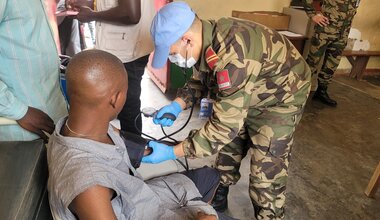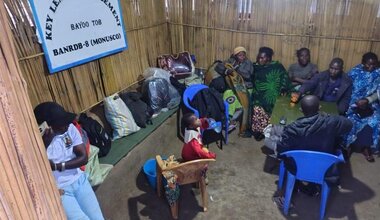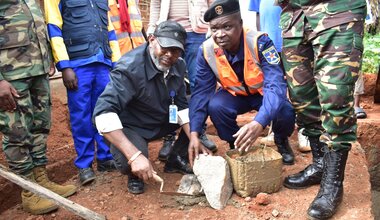Interview with MONUSCO’s Chief of DDRRR
Goma, 30 May 2011 - The Disarmament, Demobilization, Repatriation, Reintegration, and Resettlement (DDR/RR) Section of MONUSCO is responsible for repatriating all foreign combatants in the DRC and assisting the government in demobilizing the Congolese combatants. The following is an exclusive interview with DDR/RR Director Gregory Alex.
1. What are the operational workings of the DDR/RR Section?
DDR/RR has approximately 160 staff, most of whom are Congolese nationals. The DDR/RR national headquarters are based in Goma with provincial team sites in Kalemie (Katanga), Bukavu (South Kivu), Goma (North Kivu), and Dungu (Oriental). Each of these provincial team sites is responsible for deploying and maintaining field team sites in areas close to where the combatants are operating. These team sites are nearly always co-located with MONUSCO military contingents who ensure the security of DDR/RR staff and the ex-combatants who wish to demobilize. At any one time, DDR/RR is simultaneously operating 25 field team sites.
DDR/RR uses a variety of methods to convince combatants to return. The first is through radio broadcasts on 14 mobile FM radios deployed at the field team site level. These radios transmit messages from ex-combatants, their family members and local authorities to urge the combatants to leave the forest and return to civilian life. These messages are also broadcast on Radio Okapi.
DDR/RR designs leaflets with messages from ex-combatants as well as details about the repatriation and demobilization processes. This allows the combatant to be better informed about what lies ahead and urges him to take an informed decision about the next stage in his life. These leaflets are distributed by hand or are dropped by helicopter. The latter method allows DDR/RR to target areas which are difficult to access.
The third way of sensitizing combatants is through sensitizing the communities where they live. Working with the local community is a time consuming but worthwhile in the long run. In DDDRRR, the voice giving the message is often as important as the message itself so we try to get the communities to participate as much as possible in convincing the combatants to go back to civilian life.
Finally, DDR/RR also conducts direct negotiations with combatants. DDR/RR staff members are specialized in developing relationships with the combatants when they are still active. Combatants often have legitimate concerns in regard to their security, the fate of their families and future livelihoods. These negotiations address those individual concerns with the aim of convincing the combatant to leave the forest.
2. Can you explain the status of the foreign and Congolese armed groups in the DR Congo?
Yes - there are four main foreign armed groups operating in the DR Congo. They include the FDLR who are composed of former members of the Rwandan army and government as well as Rwandan refugees who entered DRC in 1994 after the genocide. The FDLR is the largest group estimated at between 2,000 and 2,500 combatants. These elements are located in the Kivus and some parts of Katanga provinces. Another group is the Allied Democratic Forces (ADF), a Ugandan rebel group that entered the DRC in the late 1990s. They are an Islamist group and want to establish Shari'a law in Uganda. This group is highly secretive but we estimate their force to be between 500 – 800 combatants. They operate in the Rwenzori Mountain range along the Ugandan border, east of Beni. The third group is the Lord's Resistance Army or LRA. They are also a Ugandan rebel group who have existed for over 20 years but only entered the DRC in 2005. The LRA are a particularly violent rebel group that has inflicted considerable sufferings on civilians in their areas of operation. In the DRC, the LRA are located in the Uele Territories of Oriental Province but they are also located in eastern Central African Republic and Southern Sudan. The remote location of the LRA makes this group particularly challenging to sensitize. Finally, there is a Burundian rebel group called the Forces Nationales de la Liberation (FNL) who recently restarted activities in South Kivu. The FNL previously integrated into the Burundian government and military but restarted activities after the Burundian elections in 2010.
Congolese combatants are members of a variety of militia ranging from self-defense groups to bandits who are mostly located in the Kivus. It is important to understand that DDR/RR only assists the Congolese government in demobilizing Congolese combatants, of which there are approximately 4,000 believed to be left in the Kivus, with 1,000 of those being members of foreign armed groups such as the FDLR or ADF.
3. What success stories can the DDR/RR Section recount as you tackle the question of foreign armed groups in the DR Congo?
Since 2002, DDR/RR repatriated over 24,000 foreign ex-combatants and their dependents to their countries of origin. The number of repatriations has increased almost three fold since the start of joint military operations in the Kivus in 2009. Prior to 2009, DDR/RR was repatriating an average of 50 foreign combatants a month, now the monthly average is around 140. This is in addition to an almost equal number of dependents. The vast majority of those repatriated are Rwandan members of the FDLR but they also include the other foreign armed groups as well as foreigners who were integrated into the FARDC.
DDR/RR has also assisted the government in demobilizing thousands of Congolese combatants. The DDR process has gone through various stages over the years. Now, with only 4,000 residual Congolese combatants left, DDR/RR is working with the government to create a process that is appropriate for those remaining. Currently, DDR/RR is processing about 100 Congolese combatants a month, most of them in North Kivu.
Since I arrived nearly two years ago, there has been a general improvement in the situation and a reduction in the overall number of illegal combatants in the DRC. The repatriation rate has similarly increased not only in numbers but also in the rank of those coming out. In 2011 alone, DDR/RR has repatriated some 20 FDLR officers including three Colonels and five Majors. At the current rate of defection, the FDLR will have difficulty continuing to exist compared to one or two years ago.
DDR/RR has also assisted in judicial proceedings against the FDLR leadership. By assisting German authorities and the International Criminal Court, the three top leaders of the FDLR were arrested and are on trial in Europe. Their arrest has had a significant impact on the morale and the command structure and control of the FDLR and is contributing to the continued defection of many in their ranks.
DDR/RR is also assisting FARDC in its training of officers on treatment of foreign and national ex-combatants, gender and human rights.
By reducing the number of illegal combatants in the Kivus, DDR/RR is contributing to the restoration of security and the creation of an environment where the government can reassert control over its territory. Both of these elements are vital to stabilization of the country.
4. What are the main challenges of the DDR/RR Section?
DDR/RR has achieved these successes despite numerous challenges. The first challenge is with the combatants themselves and the organization which tries to prevent them from surrendering. All the militias use propaganda to create fear and mistrust in the minds of the combatants to prevent them from leaving. Convincing the combatant otherwise is a major hurdle. In addition, the militias create physical barriers punishing those who attempt to defect, sometimes the punishment is death.
There are also security challenges for DDR/RR staff. We are a significant existential threat to the existence of these militias and as such our relationship with them is not always friendly. Just this year, we have had a sensitizer abducted and staff ambushed, fortunately without physical casualties. Nonetheless, the risk is there as DDRRR operates on the frontline.
Additionally, our clients (foreign armed groups) reside in remote locations and those who opt to voluntarily surrender to DDR/RR usually face security threats and punishment from their leaders. This is one of the areas where DDR/RR faces significant logistical challenges. They have to be quickly extracted from those combatants who are anxious to breakaway and come to us. Their extraction is made possible with support from MONUSCO, which in spite of its huge operational demands and limited transportation and security forces, responds positively to the DDR/RR call.
5. Do you think your current strategy regarding foreign armed groups is working? If not what new measures do you intend to put in place?
I think the current strategy regarding foreign armed groups is still working but we need to get better; adapt more quickly and more effectively. By expanding our outreach and partner network we can improve our messaging and our ability to contact clients directly in the field. I think the success of our strategy is evident in the numbers and ranks of those surrendering to MONUSCO and increasingly to FARDC. The fact that illegal combatants still inflict pain and suffering on Congolese populations means that we still have a lot of work to do.
 UN
UN United Nations Peacekeeping
United Nations Peacekeeping






